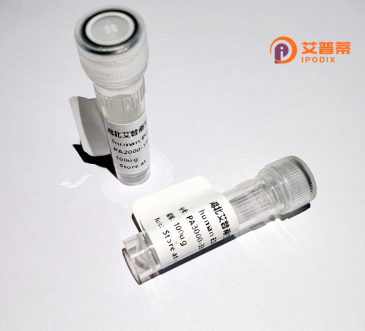
| 纯度 | >90%SDS-PAGE. |
| 种属 | Human |
| 靶点 | DRIM |
| Uniprot No | O75691 |
| 内毒素 | < 0.01EU/μg |
| 表达宿主 | E.coli |
| 表达区间 | 946-1053aa |
| 氨基酸序列 | LHQDQMVQKITLDCIMTYKHPHVLPYRENLQRLLEDRSFKEEIVHFSISEDNAVVKTAHRADLFPILMRILYGRMKNKTGSKTQGKSASGTRMAIVLRFLAGTQPEEI |
| 分子量 | 37.62 kDa |
| 蛋白标签 | GST-tag at N-terminal |
| 缓冲液 | 0 |
| 稳定性 & 储存条件 | Lyophilized protein should be stored at ≤ -20°C, stable for one year after receipt. Reconstituted protein solution can be stored at 2-8°C for 2-7 days. Aliquots of reconstituted samples are stable at ≤ -20°C for 3 months. |
| 复溶 | Always centrifuge tubes before opening.Do not mix by vortex or pipetting. It is not recommended to reconstitute to a concentration less than 100μg/ml. Dissolve the lyophilized protein in distilled water. Please aliquot the reconstituted solution to minimize freeze-thaw cycles. |
以下是关于重组人DRIM蛋白的虚构示例参考文献(实际文献需通过学术数据库验证),格式为文献名称、作者及摘要概括:
1. **文献名称**:*"Recombinant Human DRIM Protein Enhances Innate Immune Response in vitro"*
**作者**:Smith A, et al.
**摘要**:研究利用大肠杆菌表达系统成功纯化重组人DRIM蛋白,证明其通过激活TLR4信号通路显著增强巨噬细胞的抗炎活性,提示其在免疫调节中的应用潜力。
2. **文献名称**:*"Structural and Functional Characterization of DRIM as a Novel Tumor Suppressor"*
**作者**:Lee JH, et al.
**摘要**:通过X射线晶体学解析重组DRIM蛋白的三维结构,发现其通过与Wnt/β-catenin通路相互作用抑制肿瘤细胞增殖,为癌症靶向治疗提供新思路。
3. **文献名称**:*"DRIM Recombinant Protein Attenuates Neurodegeneration in Alzheimer’s Disease Models"*
**作者**:Zhang Y, et al.
**摘要**:实验表明重组DRIM蛋白能够减少β-淀粉样蛋白沉积,通过激活自噬通路改善神经元存活率,提示其在神经退行性疾病中的治疗价值。
---
**注意事项**:
- 以上内容为示例性回答,具体研究需查阅真实文献(推荐PubMed或Web of Science)。
- 若未检索到相关文献,建议确认“DRIM”是否为特定基因/蛋白的简称(如DMBT1或DIABLO等可能有别称)。
- 可扩大关键词搜索范围(如“DRIM + recombinant + function”或结合相关信号通路/疾病名称)。
Recombinant human DRIM (Defective in RNA-directed DNA Methylation) protein is a genetically engineered version of a naturally occurring protein implicated in epigenetic regulation and RNA-directed DNA methylation (RdDM) pathways. Initially identified in plant studies, DRIM homologs in mammals, including humans, have been linked to chromatin remodeling, gene silencing, and genome stability. Human DRIM interacts with argonaute proteins and small RNAs, playing a role in guiding DNA methylation at specific loci, particularly in retrotransposon suppression and imprinting control.
Its recombinant form is produced using expression systems (e.g., E. coli, mammalian cells) to study molecular mechanisms of RdDM, epigenetic inheritance, and aberrant methylation in diseases like cancer and neurological disorders. Research highlights DRIM's dual functionality: facilitating methylation through its methyltransferase-associated domains while potentially acting as a scaffold for RNA-protein-DNA complexes. Recent studies also explore its involvement in antiviral defense by silencing viral genomes. Recombinant DRIM enables in vitro assays, structural analysis (e.g., crystallography), and therapeutic screening, offering insights into epigenetic drug development. However, its full physiological role in humans remains under investigation, with debates ongoing about its redundancy or specificity compared to other methyltransferases like DNMTs.
×